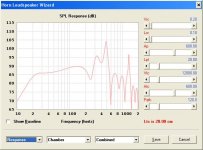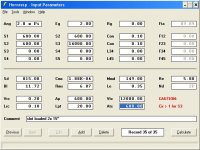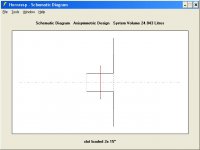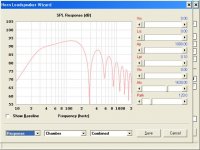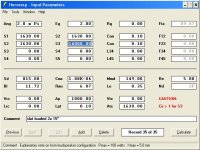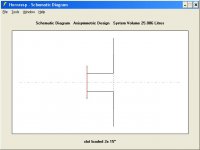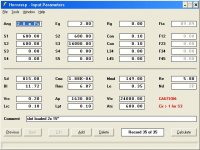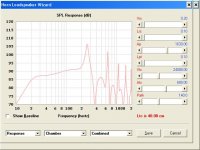Its very simple to sim this kind of "box" in Hornresp.
This is two B&C 15TBX100 in a 50% sd slot and a 1 m2 baffle.
An externally hosted image should be here but it was not working when we last tested it.
This is two B&C 15TBX100 in a 50% sd slot and a 1 m2 baffle.
Its very simple to sim this kind of "box" in Hornresp.
don't forget one major advantage of a folded dipole like this
you can have many woofers, without having a huge box
with less woofers you get less SPL
so I would think that a boxed design would need much different woofers
that is if you mate it with a Lowther like Nelson
but kind of OT I would say
Of course one of the first things I did was haul them out into the room
to measure the response difference between front and back. Here is the
(smoothed) comparison measured near field on the woofer system after
the crossover network has been applied. What you see is about about
9 dB pressure difference, equal to my 9 dB thumbnail calculation.
Hmmm .... Oh dear .... in reality practically inconsequential .....
You cannot just use pressure to indicate SPL, you need to normalise it
by multiplying it by the radiating area, otherwise you get nonsense
like small ports being more efficient than large ones, they are not.
Yes, the pressure is higher as the area is less, inevitable measured
nearfield. Farfield there is no difference, there is no efficiency gain
with the arrangement. Volume displacement is the same front and rear.
rgds, sreten.
I sort of concur with sreten on this ive been playing about with hornresp and come up with something that sort of models the design i also ran a baffle simulation and from what ive come up with the 'port' seems to be adding extra path length to the box in essence making a wide baffle but doesnt seem to improve spl.
first two graphs are what i think is a representatio of the slot loaded drivers i may be wrong. The second two are the same drivers on the same baffle without the slot. There is a slight difference in spl down low but this could just be the added baffle size.
I set both to have a path length difference of 120cm
My hornresp design may not be right though.
first two graphs are what i think is a representatio of the slot loaded drivers i may be wrong. The second two are the same drivers on the same baffle without the slot. There is a slight difference in spl down low but this could just be the added baffle size.
I set both to have a path length difference of 120cm
My hornresp design may not be right though.
Attachments
You cannot just use pressure to indicate SPL, you need to normalise it
by multiplying it by the radiating area, otherwise you get nonsense
like small ports being more efficient than large ones, they are not.
Yes, the pressure is higher as the area is less, inevitable measured
nearfield. Farfield there is no difference, there is no efficiency gain
with the arrangement. Volume displacement is the same front and rear.
You are saying my whole fallacy is wrong, and Heil transformers obviously
don't work as described.
But it's a fact that air moving at a higher velocity carries more energy
and this shows up as greater pressure.
When I said near field, I did not mean that I was sticking the microphone
in the slot - it is true that the farther away you get and as the frequency
goes lower the effect is diminished. I find that the effect is perfectly
adequate for listening purposes.
It seems like compression would find a way to do Something, especially if the front side has a "hornier" load than the back.
What if you added a deep box for the woofers with a front and rear array. The front array is mounted just like this project, the back array connected to the front array through a deep box opening well away from the OB and floor with no compression ratio. Make the front to back path something like 3 meters and apply a 9mS delay to the rear array drive. This would make about 90 degrees phase shift at 30 Hz and would somewhat reduce the needed box volume? Babble babble.
What if you added a deep box for the woofers with a front and rear array. The front array is mounted just like this project, the back array connected to the front array through a deep box opening well away from the OB and floor with no compression ratio. Make the front to back path something like 3 meters and apply a 9mS delay to the rear array drive. This would make about 90 degrees phase shift at 30 Hz and would somewhat reduce the needed box volume? Babble babble.
Last edited:
Invert half of the drivers and you have something like djk's PPSL: http://www.diyaudio.com/forums/subwoofers/177905-thread-those-interested-ppsl-enclosures.html
Frode
Frode
Attachments
I would anticipate that (unlike the drawing above) you would invert the
drive polarities. I think this has been pointed out elsewhere (probably
Linkwitz) that it allows some cancellation of 2nd harmonic.

Yes, the cancellation can yield quite an improvement when you are using less expensive drivers. Historically, I think there was a commercially available design from Electrovoice that used such a design
Keep in mind that the geometry of the cavity will act as a low pass filter. The smaller the better, although some clever person might actually use the LPF to their advantage in order to decrease higher harmonic distortion.
I would anticipate that (unlike the drawing above) you would invert the
drive polarities. I think this has been pointed out elsewhere (probably
Linkwitz) that it allows some cancellation of 2nd harmonic.

Yes, that is correct. I was a bit sloppy with the drawing.
Frode
Rudolf
What do you think of the dispersion pattern: OB - would you build it slot loaded?
It is a matter of what you want to achieve. Folding a baffle will lead to some sort of quarter wave transmission line easily. That will define an upper frequency limit. But it will allow for a much narrower baffle in the bass region.
Combining a (folding) slot with a wide baffle doesn't make much sense to me. WRT the 9 dB difference I am very much with sreten. Simply tripling the air velocity by diminishing the area to a third doesn't give more efficiency. It is NOT the same effect as AMT.
Perhaps you are simply looking at it the wrong way.
Let's analyze it from another angle using a little physics:
You will agree that the volume of air displaced to the front and back
will have to be the same for practical purposes, the acoustic equivalent
of Kirchoff's law.
Acoustic energy is the product of volume displaced at a given pressure,
the acoustic equivalent of watts = volts X amps.
For a given signal, the pressure out the front is measurably higher at any
reasonable position or distance and it is in phase with the displacement of
the woofers. Therefore, there is more energy going out the front than the
rear.
If it is not sound, where did the energy go?

Let's analyze it from another angle using a little physics:
You will agree that the volume of air displaced to the front and back
will have to be the same for practical purposes, the acoustic equivalent
of Kirchoff's law.
Acoustic energy is the product of volume displaced at a given pressure,
the acoustic equivalent of watts = volts X amps.
For a given signal, the pressure out the front is measurably higher at any
reasonable position or distance and it is in phase with the displacement of
the woofers. Therefore, there is more energy going out the front than the
rear.
If it is not sound, where did the energy go?
You are saying my whole fallacy is wrong, and Heil transformers
obviously don't work as described.
But it's a fact that air moving at a higher velocity carries more energy
and this shows up as greater pressure.
When I said near field, I did not mean that I was sticking the microphone
in the slot - it is true that the farther away you get and as the frequency
goes lower the effect is diminished. I find that the effect is perfectly
adequate for listening purposes.

Hmmm .... your calling it a fallacy, if it is, it must be wrong.
How Hiel "air" transformers work has nothing to do with this case.
Efficiency is simply volume displacement at a given level, that is it.
The point of the Heil arrangement is to increase VD over planar,
it actually does this by more efficient use of the magnetic field.
By your "theory" the narrower you make the slot the greater the
efficiency increase, this simply does not happen, in the same way
small ports with high velocity are no more efficient than larger ones.
There is no useful effect, other than the phase and dispersion issues,
which may improve, and horizontal braces in the slot would also give
force cancelling - a reason I've seen something similar before.
Forward output is no greater than the rear output, inevitably.
rgds, sreten.
Regarding very dodgy physics, some of the arguments above would
apply to nearfield listening, hardly the intended purpose here ........
To have more frontal energy requires greater acoustic coupling.
Last edited:
- Status
- This old topic is closed. If you want to reopen this topic, contact a moderator using the "Report Post" button.
- Home
- Loudspeakers
- Multi-Way
- Nelson Pass: The Slot Loaded Open Baffle Project
